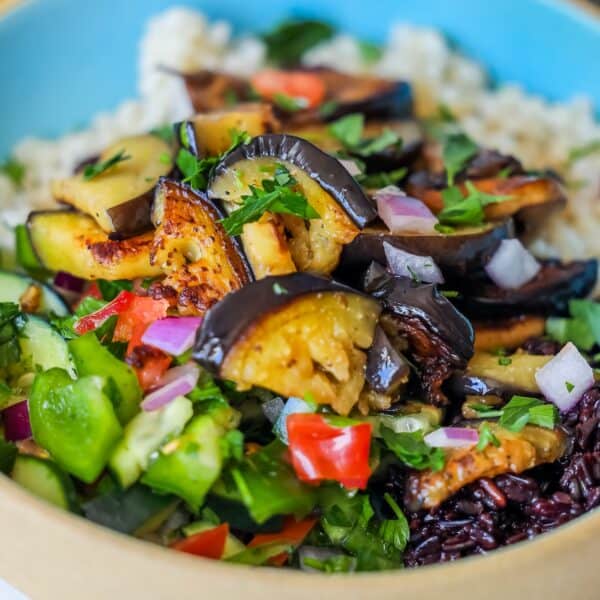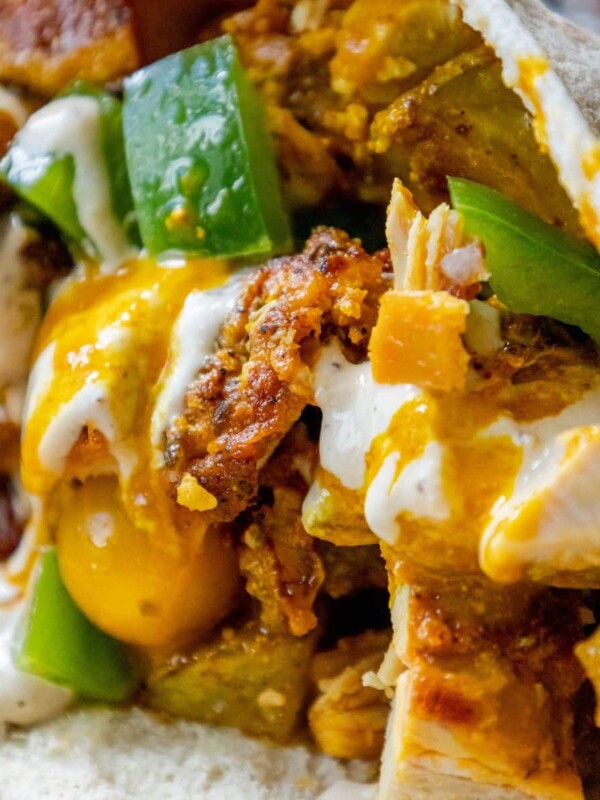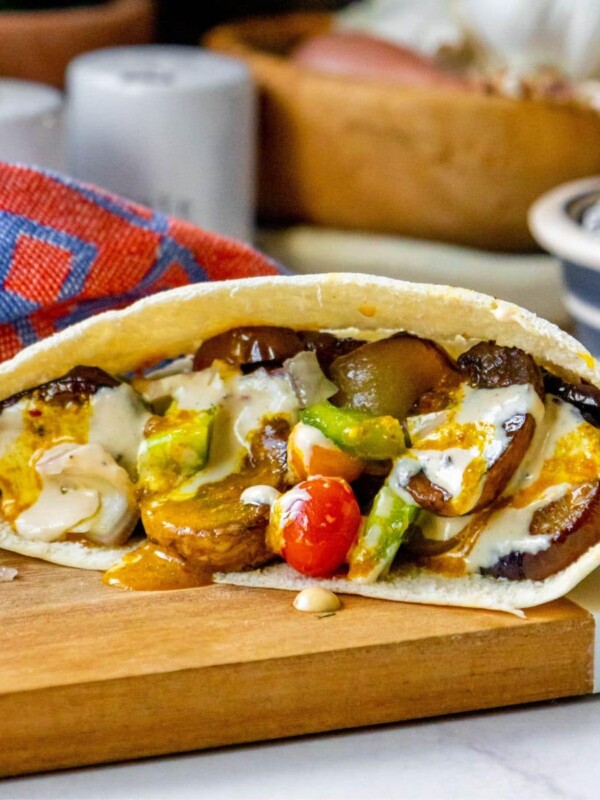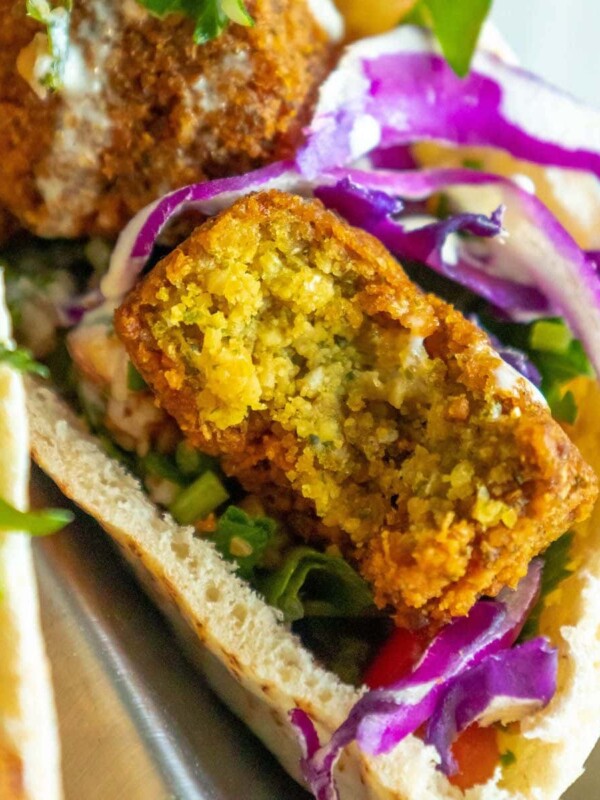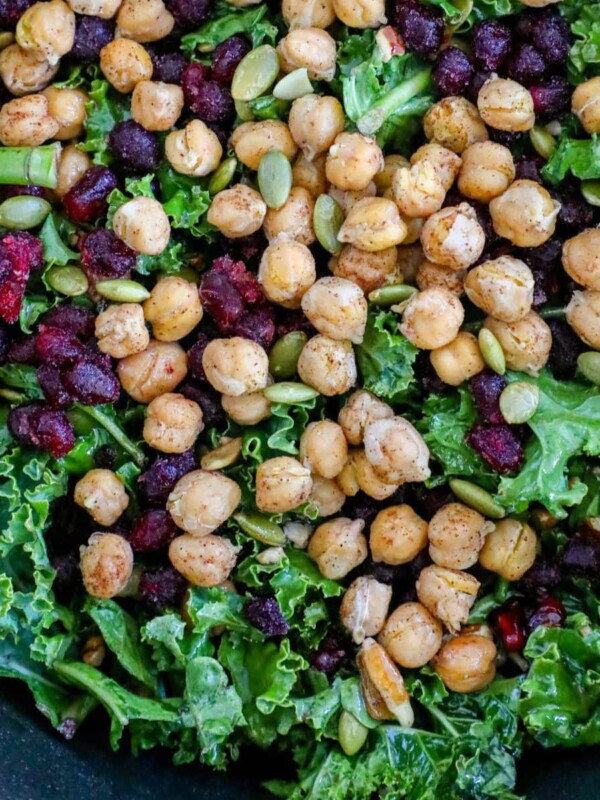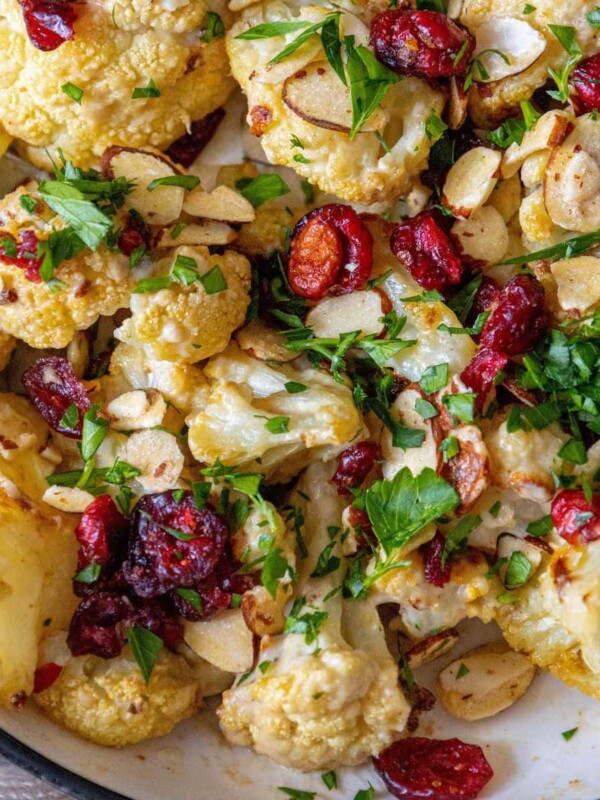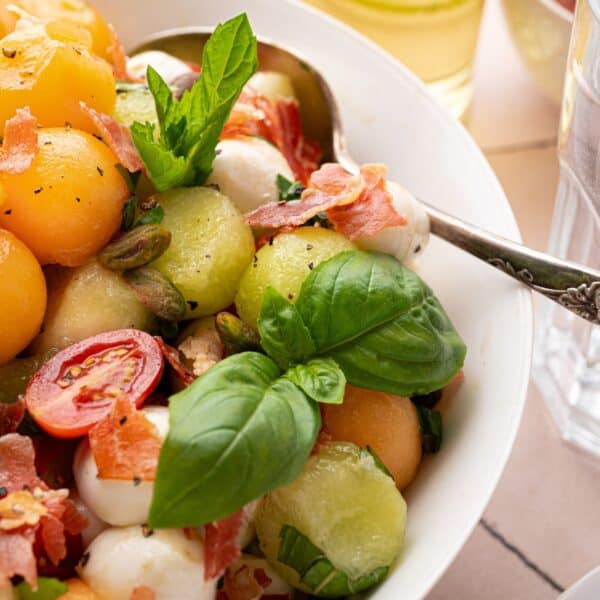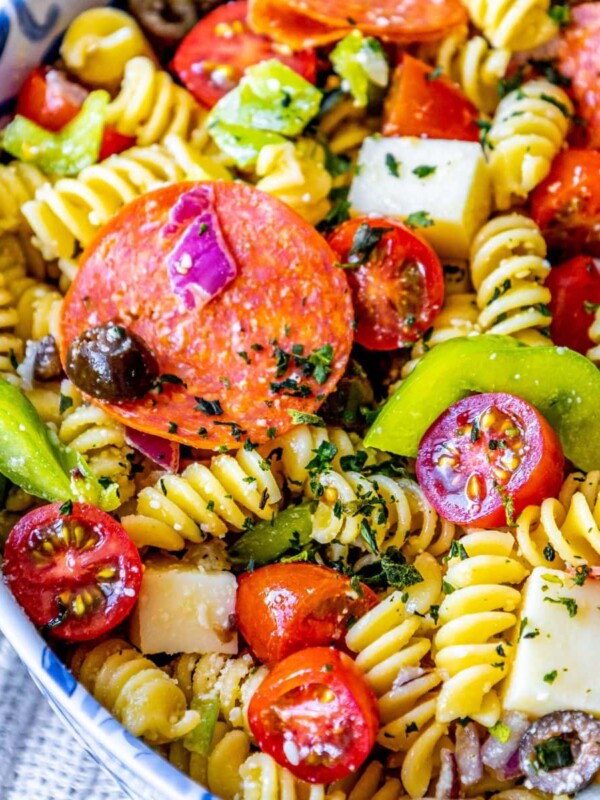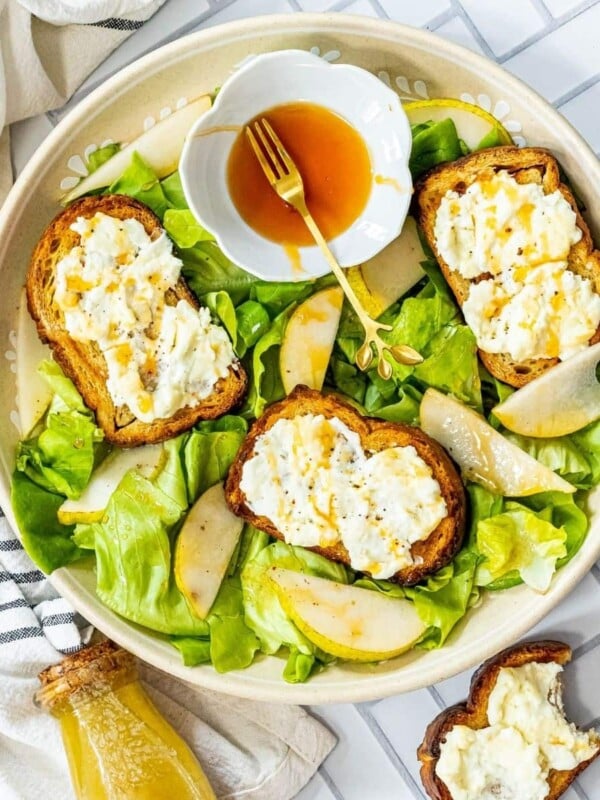This post contains affiliate links. Please read our disclosure policy.
Fresh, crisp, and delicious Fattoush salad – with toasted pita, romaine, lemon, radishes, tomatoes, and a blend of spices is a traditional Lebanese salad that is packed with fresh flavor!
I love light salads packed with fresh flavors – and fattoush delivers big on both. I eat this salad at least once a week, and have changed it up to work well with ingredients I can easily find in American grocery stores.
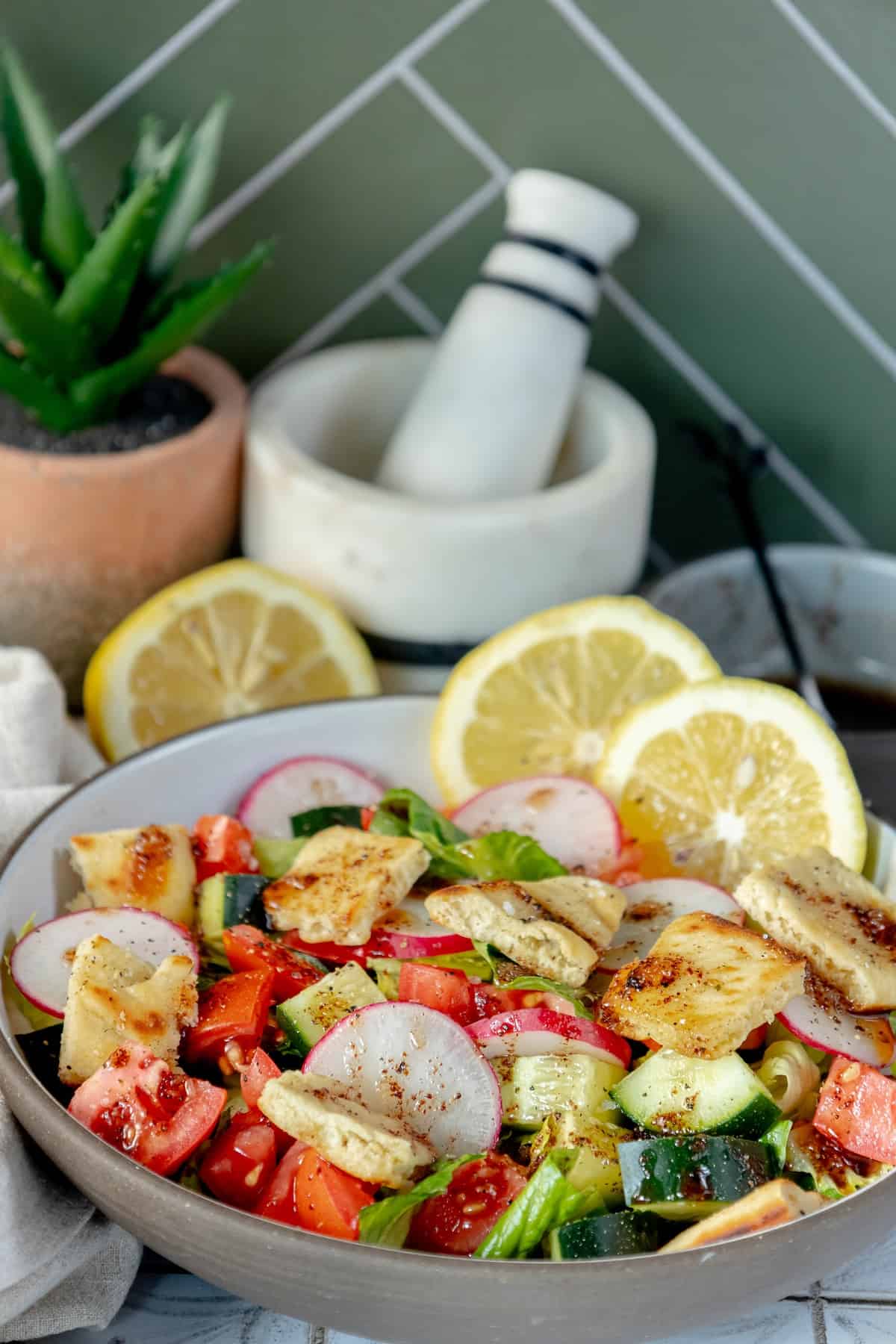
Don’t want all the extras in a recipe post? We provide a skip to recipe button in the top left corner, as well as a clickable table of contents, just below, to help make this page easier to navigate.
At Sweet C’s, I add lots of tips in all of my recipes – because I am a home cook without any formal training, and I find I am more confident making dishes when I understand why it works, and what each ingredient means to the flavor of a recipe. My goal is for even the most beginner home cook to feel empowered in the kitchen.
Table of contents
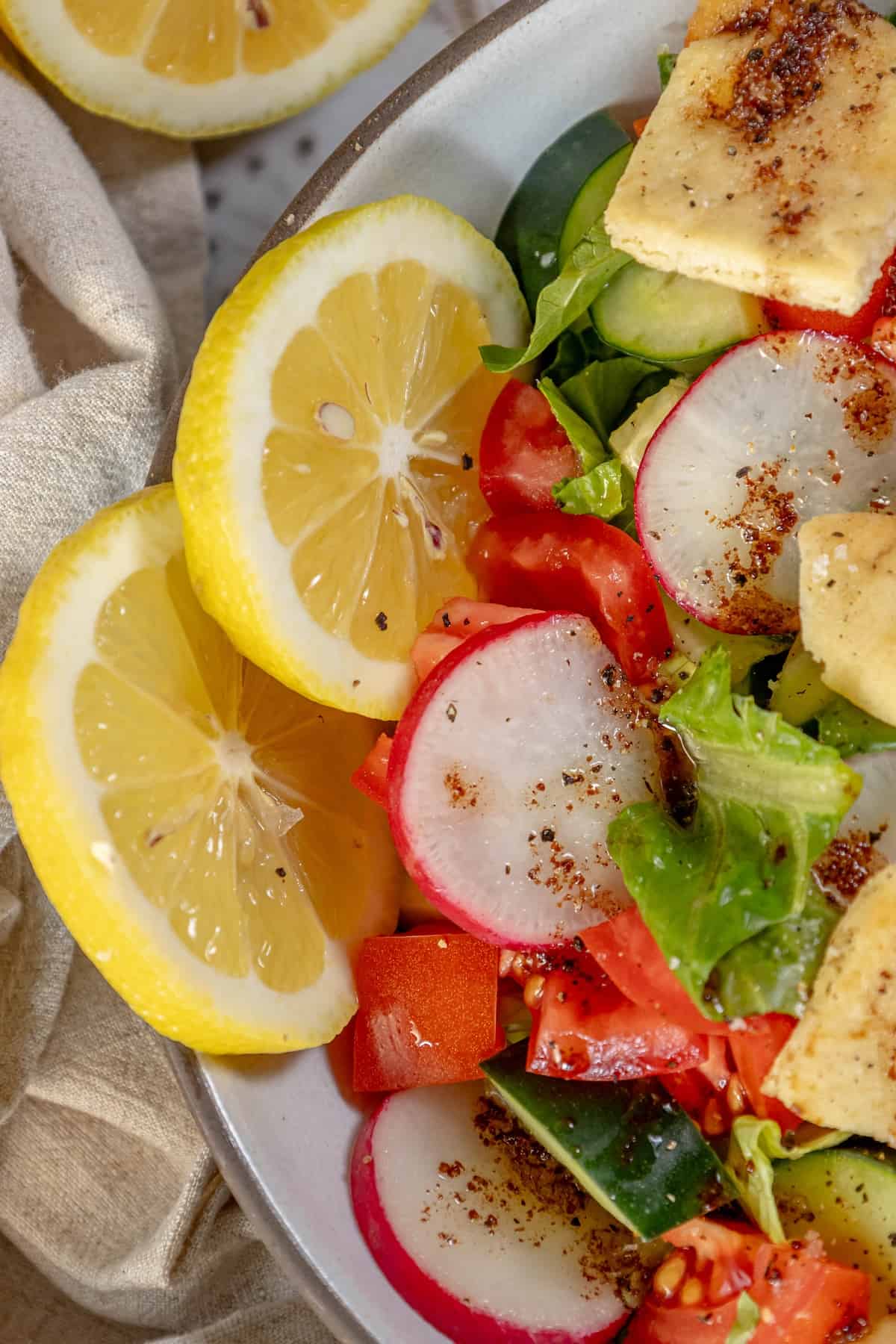
All about this Recipe for Fattoush Salad!
Fattoush is one of my favorite salads- it is bursting with fresh flavor, has unique crunchy pita croutons, and is dressed with a spice blend and oil that is truly addictive.
This Middle Eastern salad is simple to make and great for crowds – plus you can use up some of your home-grown produce! It is an affordable salad that doesn’t take too big a bite out of your budget, and is so good, picky eaters love it too. I’ve had fattoush in California from Lebanese restaurants, but truly fell in love with it while touring Israel’s far north, just across the border from Lebanon.
Fattoush originated in the rural areas of Lebanon and is a shining example of a “peasant dish,” – a dish made from readily available ingredients and leftovers.
The story goes that Lebanese farmers would take their leftover pita bread, which had become stale, and toss it with whatever fresh vegetables they had on hand. This was not only economical but also reduced food waste. The pita pieces would be toasted or fried to give them a new life, adding a crunchy texture to the salad.
What sets Fattoush apart from other salads is the use of on of my favorite spices – sumac! This tangy, lemony spice has been a staple in Middle Eastern cuisine for centuries and is what gives Fattoush its distinctive flavor. I love to sprinkle sumac in hummus, in tahini sauce, in Zhoug (Skhug) Sauce – and over grilled meats!
Over time, Fattoush crossed the borders of Lebanon and became popular throughout the Middle East. Each region added its own twist, but the core concept remained the same: a refreshing, vibrant salad that brought new life to simple, everyday ingredients.
Today, Fattoush is celebrated worldwide- not just for its budget-friendly use of ingredients but for its perfect mix of textures and flavors!
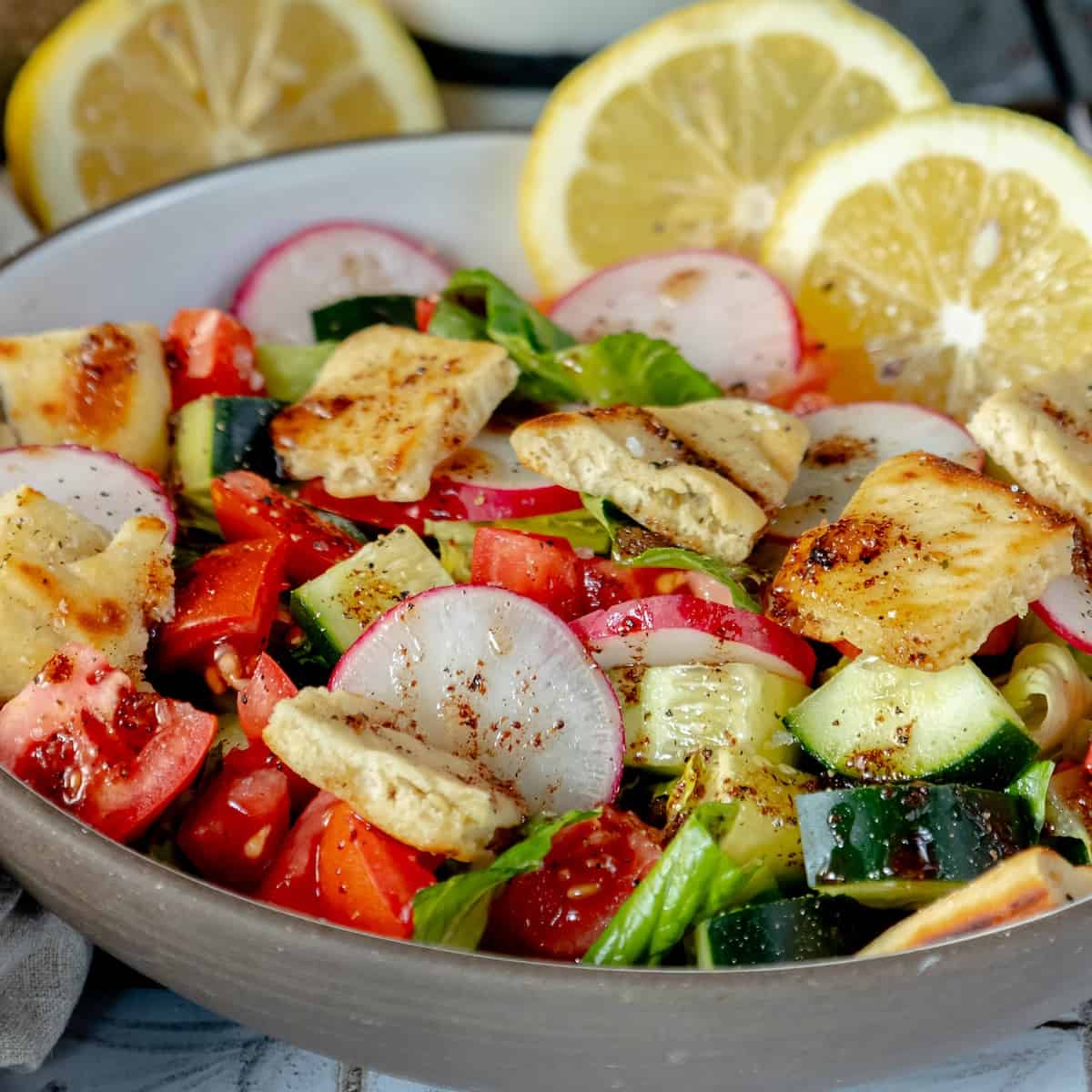
Lebanese Fattoush Salad ingredients
To make this recipe, we will need the following ingredients:
- Cucumbers: They add a cool and crisp texture to the salad. Their mild flavor balances out the stronger tastes of the other ingredients.
- Tomatoes: Tomatoes contribute a juicy and slightly sweet element. They also add a burst of color and are a good source of vitamins.
- Red Onion: The sharp, pungent flavor of red onion adds depth and a slight bite, which contrasts nicely with the milder ingredients.
- Garlic: Minced garlic brings a robust and aromatic flavor, which is a cornerstone in many Mediterranean dishes.
- Fresh Parsley: Parsley adds a fresh, slightly peppery taste. It’s also key for its vibrant green color, enhancing the salad’s visual appeal.
- Fresh Mint: Mint leaves contribute a unique, refreshing flavor that pairs exceptionally well with the other herbs and spices in the salad.
- Sumac: This tangy, lemony spice is critical in Fattoush. It adds a sour note and is often used in Middle Eastern cuisine for its flavor and health benefits.
- Lemon Juice: Fresh lemon juice provides a bright, acidic component, essential for balancing the flavors and adding a refreshing zest.
- Olive Oil: Olive oil acts as a binder for the dressing, adding a smooth and rich texture, as well as a subtle fruity flavor.
- Salt and Pepper: These seasoning staples enhance and bring out the natural flavors of the other ingredients.
- Lettuce (optional): Lettuce adds bulk and a crunchy texture, making the salad more filling and varied in texture.
- Radishes (optional): Sliced radishes contribute a peppery bite and a crisp texture, along with a splash of color.
- Pita Breads: Toasted pita bread adds a delightful crunch and a toasty flavor, acting as croutons that soak up the dressing while maintaining a bit of their crispness.



How to make Fattoush Salad
Once you’ve gathered your ingredients, we will use the following process:
- Prepare Vegetables: In a large bowl, combine cucumbers, tomatoes, red onion, garlic, parsley, and mint. Add lettuce and radishes if using.
- Make Dressing: In a small bowl, whisk together lemon juice, olive oil, sumac, salt, and pepper.
- Combine: Pour the dressing over the vegetables and toss well to combine.
- Add Pita: Just before serving, add the toasted pita pieces and toss gently.
- Serve: Serve immediately, garnished with extra sumac if desired.
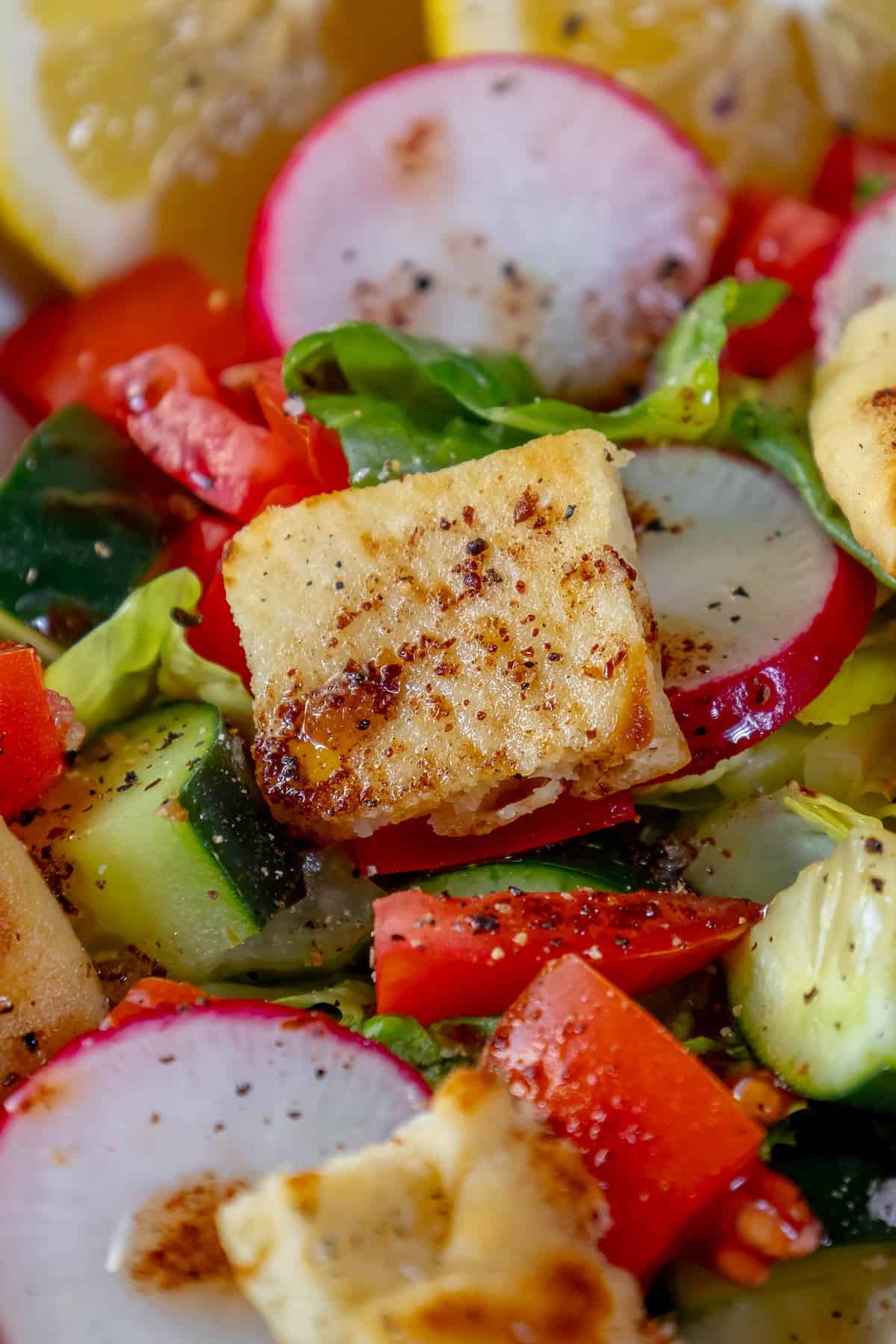
Tips and tricks for making perfect Fattoush Salad
Use Fresh Ingredients: The key to a great Fattoush is using the freshest vegetables you can find. Fresh, crisp cucumbers, ripe tomatoes, and vibrant herbs are essential.
Properly Prep the Vegetables: Dice your cucumbers and tomatoes in uniform sizes for a pleasant texture and appearance. Thinly slice your red onions to avoid overpowering the salad with their strong flavor.
Toast the Pita Bread: Toast your pita bread until it’s golden and crispy. This adds a crunch to your salad, providing a contrast to the softer vegetables. You can either bake or fry the pita, but baking is a healthier option.
Dressing Balance: The dressing should have a good balance of tart and savory. Lemon juice and sumac provide the tartness, while olive oil adds smoothness. Adjust the quantities to suit your taste, but remember, the sumac is a standout ingredient in Fattoush.
Dress at the Last Minute: To keep the pita bread crispy, add the dressing and toasted pita to the salad right before serving. This prevents the bread from becoming soggy.
Season Well: Don’t forget to season your salad with salt and pepper. These basic seasonings will help to enhance all the natural flavors of the ingredients.
Herbs are Your Friends: Don’t skimp on the parsley and mint. These herbs are integral to the salad, adding freshness and a burst of flavor.
Serve Immediately: Fattoush is best enjoyed fresh. The longer it sits, the more the textures will change, especially the crispness of the pita.
Best Fattoush Salad Recipe variations
Add a Protein (Optional): For a more filling version, you can add grilled chicken, chickpeas, or feta cheese. This makes the salad hearty enough to be a standalone meal.
Experiment with Additional Ingredients: While traditional Fattoush has a set list of ingredients, feel free to add other vegetables like bell peppers or avocado for extra texture and flavor.
What if I can’t find sumac?
While sumac is a key ingredient, if you can’t find it, you can substitute it with a bit more lemon juice or zest to mimic its tangy flavor.
Can I add other ingredients in Fattoush?
Absolutely! While there’s a traditional set of ingredients, many people add extras like bell peppers, radishes, feta cheese, or even protein like grilled chicken or chickpeas.
Can I make a gluten-free version?
Yes, you can make Fattoush gluten-free by using gluten-free pita bread.
Fattoush Salad Recipe FAQs
Fattoush is a traditional Lebanese salad made with mixed greens, fresh vegetables, herbs, and toasted or fried pieces of pita bread. It is dressed with a zesty dressing, typically including lemon juice, olive oil, and sumac.
The unique aspect of Fattoush is the use of sumac and toasted pita bread. Sumac adds a tangy, lemony flavor that sets it apart from other salads, while the pita adds a delightful crunch.
You can prep the vegetables ahead of time, but it’s best to assemble the salad just before serving to prevent the pita from getting soggy and to keep the vegetables crisp.
Yes, Fattoush is generally healthy. It’s loaded with fresh vegetables and herbs, and uses heart-healthy olive oil. The pita bread adds some carbohydrates, but you can use whole wheat pita for a healthier option.
It’s best eaten fresh, but if you have leftovers, store them in the fridge in an airtight container. Note that the pita will soften over time.
Yes, traditional Fattoush is both vegan and vegetarian, as it mainly consists of vegetables, herbs, and bread.
Fattoush pairs well with a variety of Middle Eastern dishes, such as hummus, baba ganoush, grilled meats, and kebabs.

What to serve with this Fattoush Salad Recipe
Grilled Meats: Fattoush complements grilled meats wonderfully. Think grilled chicken, lamb, or beef kebabs. The freshness of the salad balances the richness of the meat.
Kebab Platters: Serve alongside different types of kebabs, like shish kebab (skewered meat), kofta kebab (ground meat), or even grilled vegetable kebabs for a vegetarian option.
Hummus and Baba Ganoush: These classic Middle Eastern dips made from chickpeas and eggplants, respectively, are great with Fattoush. Serve with extra pita bread for dipping.
Stuffed Grape Leaves (Dolmas): These are often served as appetizers and offer a nice contrast in flavor and texture to Fattoush.
Rice Dishes: Serve it alongside rice dishes like pilaf or biryani. The lightness of the salad pairs well with the heartier rice.
Falafel: These crispy chickpea patties are a great vegetarian option and go nicely with the crisp, fresh elements of the salad.
Tabbouleh: Another popular Lebanese salad, tabbouleh, can be served alongside Fattoush for a refreshing and herb-filled meal.
Roasted or Grilled Vegetables: Simple roasted or grilled vegetables like eggplant, zucchini, and bell peppers complement the flavors in Fattoush.
Fish and Seafood: Grilled or baked fish, like salmon or branzino, pairs nicely with Fattoush, offering a light yet satisfying meal.
Lebanese Flatbreads: Serve with a variety of Lebanese flatbreads, like manakish or lahmacun, for a more filling meal.
Try these other favorites:
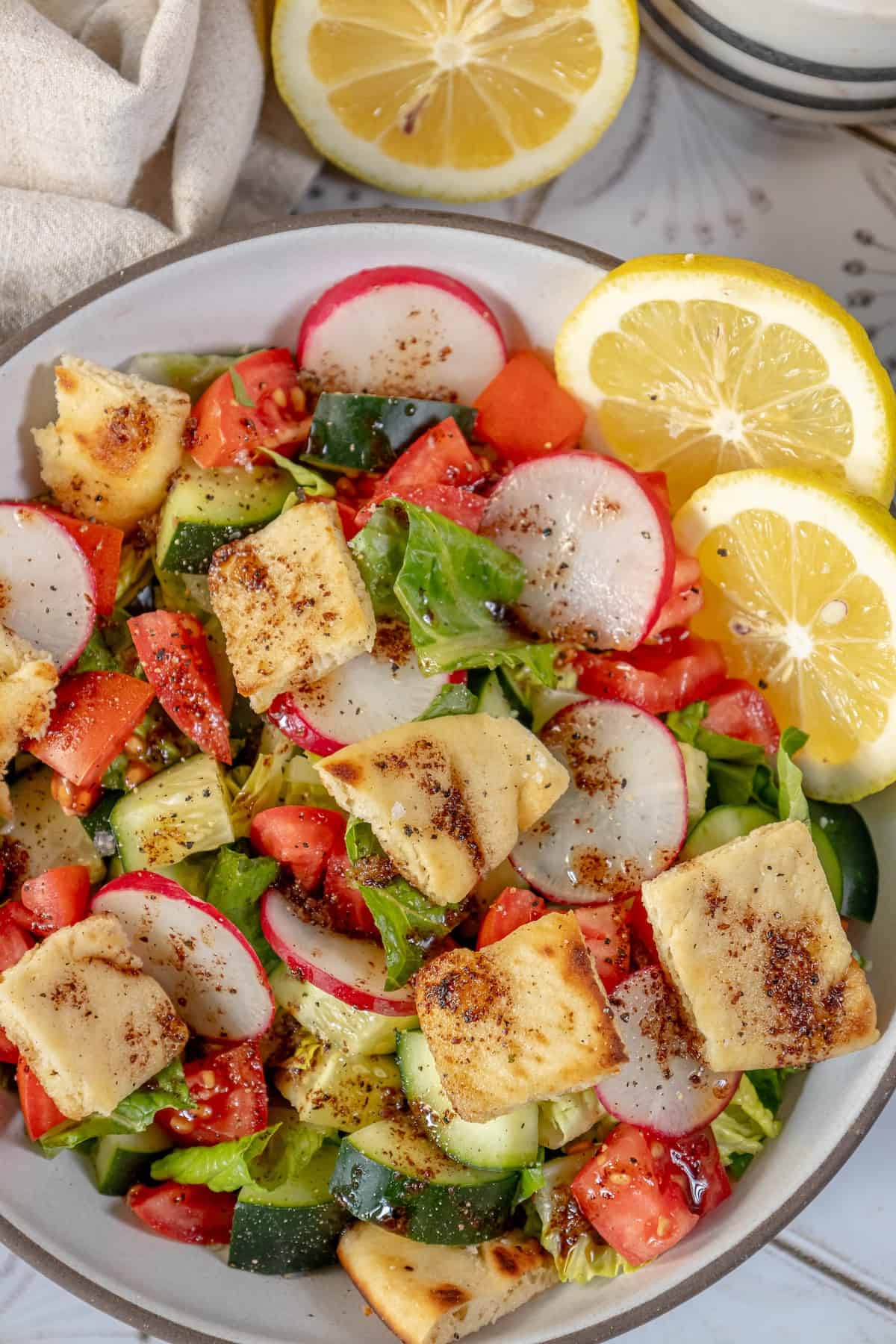
If you love this easy recipe please click the stars below to give it a five star rating and leave a comment! Pease also help me share on Instagram, Facebook, and Pinterest!
Share on Facebook
SharePin this now to find it later
Pin ItFollow on Instagram
Click here to view the web story for this recipe!
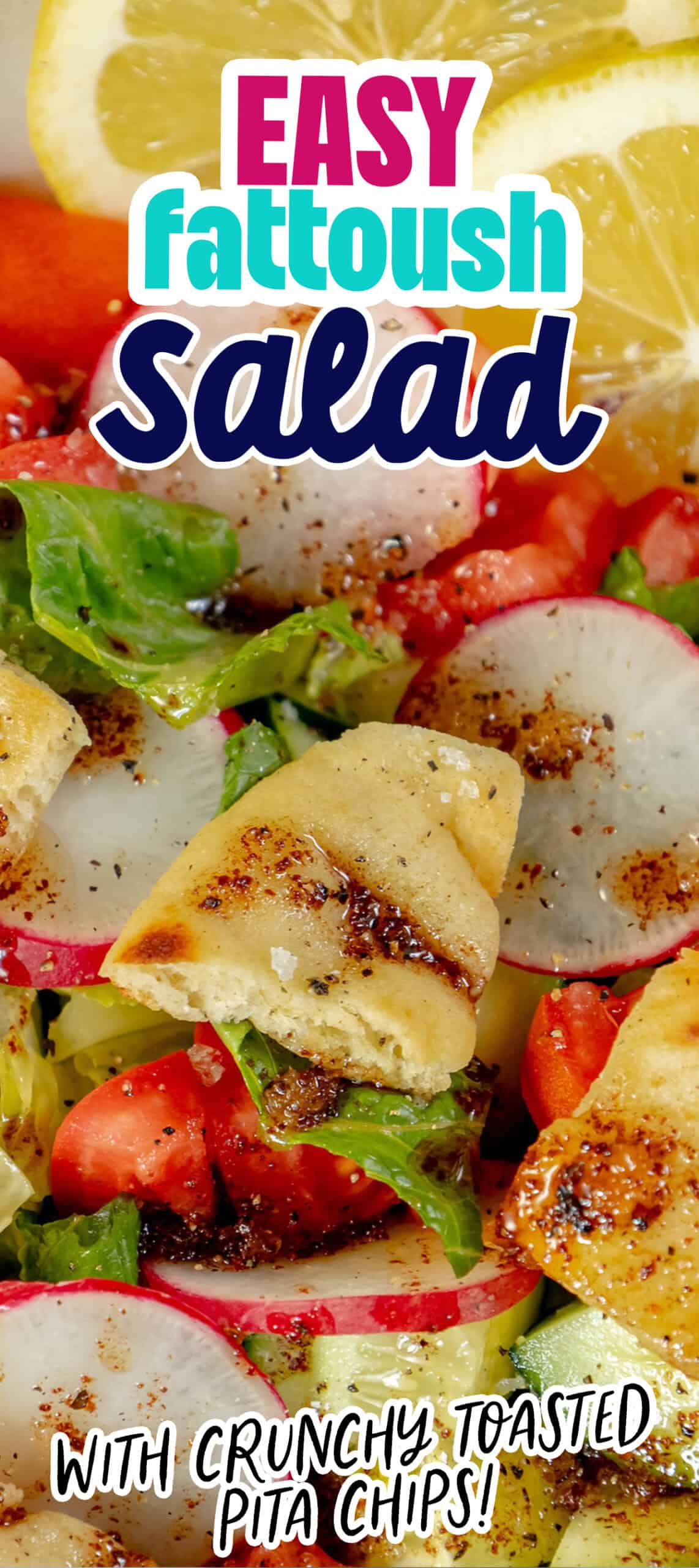
Only have 30 minutes to get dinner on the table? Sign up for my 30 minute dinner plans direct to your inbox!
Find and shop my favorite products in my Amazon storefront here!
Recipe for Fattoush Salad

Equipment
Ingredients
- 2 medium cucumbers, diced
- 4 medium tomatoes, diced
- 1 red onion, thinly sliced
- 2 cloves of garlic, minced
- 1 cup of chopped fresh parsley
- ½ cup of chopped fresh mint
- 2 tablespoons of sumac
- Juice of 2 lemons
- ⅓ cup of olive oil
- Salt and pepper, to taste
- 2 cups of lettuce, chopped (optional)
- 1 cup of radishes, sliced (optional)
- 2 pita breads, toasted until golden and broken into pieces
Instructions
- Preheat oven, air fryer, or grill to 350 degrees.
- Chop pitas into small squares and lightly brush with olive oil, season with salt and pepper.
- Toast pita croutons 5-8 minutes, until crunchy. Remove and let cool.
- In a large bowl, combine cucumbers, tomatoes, red onion, garlic, parsley, and mint. Add lettuce and radishes.
- In a small bowl, whisk together lemon juice, olive oil, sumac, salt, and pepper.
- Pour the dressing over the vegetables and toss well to combine.
- Just before serving, add the toasted pita pieces and toss gently.
- Serve immediately, garnished with extra sumac if desired.
Nutrition
Nutrition information is automatically calculated, so should only be used as an approximation.
